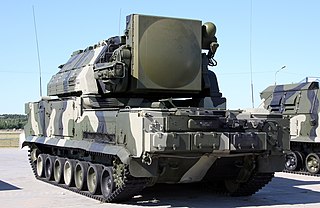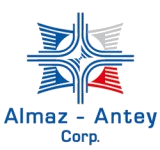
The S-300 is a series of long-range surface-to-air missile systems developed by the former Soviet Union. It was produced by NPO Almaz for the Soviet Air Defence Forces to defend against air raids and cruise missiles.

The S-125 Neva/Pechora is a Soviet surface-to-air missile system that was designed by Aleksei Isaev to complement the S-25 and S-75. It has a shorter effective range and lower engagement altitude than either of its predecessors and also flies slower, but due to its two-stage design it is more effective against more maneuverable targets. It is also able to engage lower flying targets than the previous systems, and being more modern it is much more resistant to ECM than the S-75. The 5V24 (V-600) missiles reach around Mach 3 to 3.5 in flight, both stages powered by solid fuel rocket motors. The S-125, like the S-75, uses radio command guidance. The naval version of this system has the NATO reporting name SA-N-1 Goa and original designation M-1 Volna.

The Buk is a family of self-propelled, medium-range surface-to-air missile systems developed by the Soviet Union and its successor state, the Russian Federation, and designed to counter cruise missiles, smart bombs and rotary-wing aircraft, and unmanned aerial vehicles. In the Russian A2AD network, Buk is located between the S-200/300/400 systems above and the point defense Tor and Pantsir type systems below.

The Tor is an all-weather, low-to medium-altitude, short-range surface-to-air missile system designed for destroying airplanes, helicopters, cruise missiles, unmanned aerial vehicles and short-range ballistic threats (anti-munitions). Originally developed by the Soviet Union under the GRAU designation 9K330 Tor, the system is commonly known by its NATO reporting name, SA-15 "Gauntlet". A navalized variant was developed under the name 3K95 "Kinzhal", also known as the SA-N-9 "Gauntlet". Tor was designed to shoot down guided weapons like the AGM-86 ALCM and BGM-34 day and night, in bad weather and jamming situations. Tor can detect targets while on the move. The vehicle must stop intermittently when firing, although trials have been conducted with the goal of eliminating this restriction.

OKB is a transliteration of the Russian initials of "опытно-конструкторское бюро" – opytno konstruktorskoye byuro, meaning 'experiment and design bureau'. During the Soviet era, OKBs were closed institutions working on design and prototyping of advanced technology, usually for military applications. The corresponding English language term for such a bureau's activity is R&D or "research and development."

The S-400 Triumf, previously known as the S-300 PMU-3, is a mobile surface-to-air missile (SAM) system developed in the 1990s by Russia's NPO Almaz as an upgrade to the S-300 family of missiles. The S-400 was approved for service on 28 April 2007 and the first battalion of the systems assumed combat duty on 6 August 2007. The system is complemented by its successor, the S-500.

The S-300VM "Antey-2500" is a Russian anti-ballistic missile system. The system is designed to target short- and medium-range ballistic missiles, aeroballistic missiles, cruise missiles, fixed-wing aircraft, loitering ECM platforms, and precision-guided munitions.

NPO Novator is a Russian company that designs long-range anti-aircraft missiles. It was established in 1947 as OKB-8 in Sverdlovsk, became independent in 1991, and then became part of the Almaz-Antey conglomerate. It is perhaps best known for designing the 9M82 and 9M83 missiles of the S-300V SAM system.

The S-500 Prometheus, also known as 55R6M "Triumfator-M", is a Russian surface-to-air missile/anti-ballistic missile system supplementing the S-400 and the A-235 ABM missile system. The S-500 was developed by the Almaz-Antey Air Defence Concern. Initially planned to be in production by 2014, the first unit entered service in 2021 with the 15th Aerospace Army. Russia claims that the S-500 is capable of intercepting all types of modern hypersonic weapons, and has claimed to have successfully tested such capability. Russia is reportedly planning to deploy the S-500 alongside the planned S-550 missile system as part of its air defense network.

JSC Concern VKO "Almaz-Antey" is a Russian state-owned company in the arms industry, a result of a merger of Antey Corporation and NPO Almaz, unifying some of the national military enterprises, in particular, the developers of anti-aircraft defence and cruise missile systems. The organisation is headquartered in Moscow and is the world's eighth-largest defence contractor measured by 2017 defence revenues. In 2017, Almaz-Antey had arms sales of $9.125 billion.

OJSC Dolgoprudnenskoye Scientific Production Plant or DNPP for short is a Soviet/Russian designer and mass producer of surface-to-air missiles located in the city of Dolgoprudny, Moscow Oblast.

Marine Scientific Research Institute of radioelectronics or MNIIRE Altair design bureau is a Soviet/Russian enterprise, developer of naval SA missile systems and radars. Headquartered in Moscow.

Missile defense systems are a type of missile defense intended to shield a country against incoming missiles, such as intercontinental ballistic missiles (ICBMs) or other ballistic missiles. The United States, Russia, India, France, Israel, Italy, United Kingdom, China and Iran have all developed missile defense systems.

JSC Scientific and Research Institute of Measurement Instrumentation – Novosibirsk Plant named after the Komintern – Soviet/Russian large scientific and production joint venture (NPO) working in the field of radiotechnics. Both NIIIP and NZiK located in Novosibirsk. General director is Pavel Zabolotniy.

JSC Design Bureau for Special Machine-Building is a Soviet-Russian space rockets industry enterprise. Currently, it is part of Almaz-Antey.
The S-350 Vityaz is a Russian medium-range surface-to-air missile system developed by GSKB Almaz-Antey. Its purpose is to replace the S-300PS. The system design traces its roots from the joint South Korean-Russian KM-SAM project and uses the same 9M96 missile as the S-400 missile system.

The Territorial Air Defence Force is an armed service/branch of the Algerian People's National Army, the armed forces of Algeria. It is one of the four service branches of the Algerian Armed Forces, along with the army, navy, and air force. It is tasked with the Algerian airspace protection mission. Its current commander is Major-General Amer Amrani.
Antey Concern was a defense industry company based in Moscow, Russia. In 2002 it was merged with NPO Almaz to form Almaz-Antey.
The scientific production association is a form of scientific research-to-production enterprise in the Soviet Union and its successor states, including Russia and other union republics.

The 9M337 Sosna-R (Pine) (SA-X-25) is a Russian radar and laser-guided supersonic two-stage missile. It is used in Sosna-R short range air defense missile system designed to protect military units from air attacks in all types of combat situations, including during march.


















